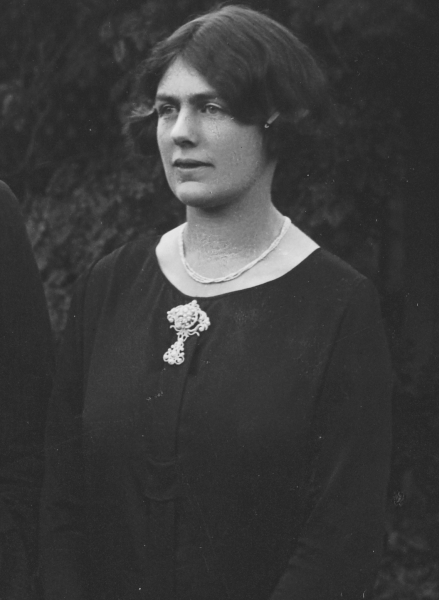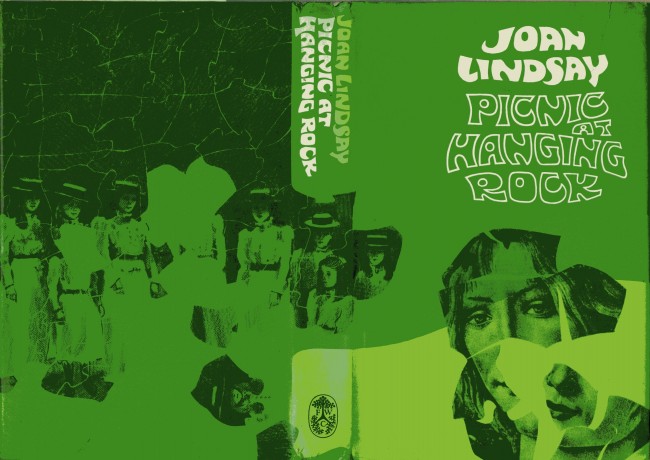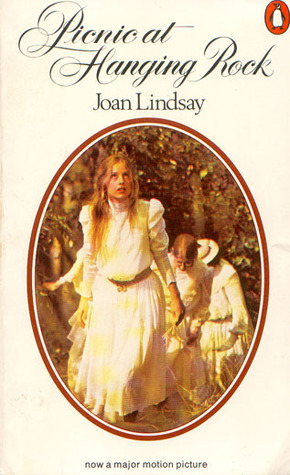Picnic at Hanging Rock by Joan Lindsay
By Rose
 It is a well-known fact that the environment can affect the mind and thoughts. This is demonstrated through research in environmental psychology. Whether it be a room, house, the city or countryside, the landscape we find ourselves in can impact our minds. Our minds react to what we see and feel.
It is a well-known fact that the environment can affect the mind and thoughts. This is demonstrated through research in environmental psychology. Whether it be a room, house, the city or countryside, the landscape we find ourselves in can impact our minds. Our minds react to what we see and feel.
In Joan Lindsay’s novel ‘Picnic at Hanging Rock’ first published in 1967, she uses one of the most atmospheric environments in Australia for the backdrop of her story, Hanging Rock in Victoria, an unusual volcanic formation that has a great history and emanates power and mystery. It’s said that Lindsay believed it had magic powers. Due to weathering and erosion the rock shapes are different than many others and are described by many as rare. The stones stand high like sentinels protected by luscious green trees.
This is a novel where the environment becomes the most powerful character in the story. The hanging rock is given more authority, through the dialogue communicated to the schoolgirls in the narrative. They are told that the rock is millions of years old, that it is singular, and it is described as a superior structure. This knowledge, that the rock existed in ancient times, draws four girls, and one teacher, further into its sphere. Here, the environment not only affects the minds of the girls but creates a place where the schoolgirls, having lived with under strict rules, feel able to break free of rules and put their safety at risk, something they probably wouldn’t have considered under the care of the headteacher.
It is St Valentine’s day and all the schoolgirls are excited by dreams of love. They exchange romantic valentines’ cards, elaborately decorated. It’s a warm day and Lindsey describes the beauty of the day in a very dreamy style of writing. The schoolgirls and teachers visit Hanging Rock for a special picnic.
An ancient King in a wild domain, Hanging Rock stands bold, emanating authority and mysticism. As the dreamy hot afternoon advances, man-made time suddenly halts, the characters’ watches break. The rules of an ordered society begin to slip away under a sweltering sun. The rules of nature and not the rules of society. A different time exists here, a time that goes back into history.
 A few girls seduced by the archaic stones, advance towards them it as if in a hypnotic trance, mesmerised by the towering formations. Exploring tunnels and crevices, they loosen underclothes, becoming more at one with nature. They dance with closed eyes, they sleep while lizards crawl alongside their arms and ants march across pale soft hands. They stop identifying with the school group far below them. They see themselves as part of something phenomenal that transcends the normal world and man-built society. They dissociate from the world they have lived in. The monument seems to be weaving an archaic spell inside their minds, awaking primitive feelings and affecting their behaviour.
A few girls seduced by the archaic stones, advance towards them it as if in a hypnotic trance, mesmerised by the towering formations. Exploring tunnels and crevices, they loosen underclothes, becoming more at one with nature. They dance with closed eyes, they sleep while lizards crawl alongside their arms and ants march across pale soft hands. They stop identifying with the school group far below them. They see themselves as part of something phenomenal that transcends the normal world and man-built society. They dissociate from the world they have lived in. The monument seems to be weaving an archaic spell inside their minds, awaking primitive feelings and affecting their behaviour.
Hanging rock is the ruler of this domain, it makes the schoolgirls and teachers appear fragile and small and weak. The trees, insects, lizards and the parrots that soar above the girl’s heads are the like the rock’s subjects. They carry on their work as human beings eat, crawling over the food, crawling over their hands. It’s as if Lindsay is saying that nature cannot be suppressed and controlled by human beings. Once they enter the natural domain, control is impossible, they must contend with a set of overpowering elements, that they would not find in manmade society.
In this wilderness, three girls are seduced by the rocks, and while the others have fallen into a deep sleep, that seems strangely orchestrated by powers unseen. The girls decide to climb the ancient rock by themselves. The archaic stones mesmerise them, drawing them into the very core of Hanging Rock. A place they have been forbidden to climb due to its dangers, ultimately the girls' minds will alter, their identity and their behaviour dramatically changing.
As if in a hypnotic trance, the girls tread higher, exploring tunnels and crevices, their hands pressing against the moss-covered rock surfaces. They begin to dissociate from manmade rule-based society, from school and teachers. They stop identifying with the group they were part of when they arrived. Their identity is now becoming aligned with ancient volcanic rocks. They see themselves as part of something phenomenal, that transcends the normal world. At one point they stop and look down at the rest of the school group, far below on the ground. They comment that the lives of the sleeping group seem purposeless. That way of living, that they had lived for years, no longer seems important to the girls within a short time of climbing the mysterious rock.
The monument appears to be weaving an archaic spell inside their minds, awakening a primaeval mood that once switched on is impossible to retract. They loosen tight underclothes and remove stockings, becoming less inhibited, sensuality opening inside them. They dance and drift to an unearthly vibration that seems to communicate something locked deep inside their minds. Three of them, two girls and one teacher, will never return, their bodies will never be found.
 Other themes are the unfairness of the social classes. Most of the main characters come from wealthy families, but there are two orphans in the story. One of the orphans, Sarah, has an unknown benefactor paying her school bills. She is cruelly treated by the headmistress. The wealthy school girls with great social standing and social power are treated very differently at the school. The power of physical beauty and obsession is also a theme. The beauty of nature, flowers, swans, clothes, the beauty of the girls is a common theme, descriptions of the angelic Miranda with her long golden hair and dreamy gaze. When a handsome young man sees Miranda crossing a lake for only a moment, he becomes obsessed with her image. Her beauty seems to have caused an obsession inside his mind. But more than that, it appears as though her physical ethereal beauty gives an impression of her personality. Possibly the power of physical beauty is used in this novel. It will be this beauty that drives him to travel to the rock to try and find the missing girls. The French teacher describes Miranda as being like a ‘Botticelli Angel’, the second girl climbing, the only one to survive after a week missing, is also described as being exquisitely beautiful. Lindsay certainly likes her beautiful dreamy Botticelli angels and uses physical beauty throughout the novel in her descriptions and character depictions.
Other themes are the unfairness of the social classes. Most of the main characters come from wealthy families, but there are two orphans in the story. One of the orphans, Sarah, has an unknown benefactor paying her school bills. She is cruelly treated by the headmistress. The wealthy school girls with great social standing and social power are treated very differently at the school. The power of physical beauty and obsession is also a theme. The beauty of nature, flowers, swans, clothes, the beauty of the girls is a common theme, descriptions of the angelic Miranda with her long golden hair and dreamy gaze. When a handsome young man sees Miranda crossing a lake for only a moment, he becomes obsessed with her image. Her beauty seems to have caused an obsession inside his mind. But more than that, it appears as though her physical ethereal beauty gives an impression of her personality. Possibly the power of physical beauty is used in this novel. It will be this beauty that drives him to travel to the rock to try and find the missing girls. The French teacher describes Miranda as being like a ‘Botticelli Angel’, the second girl climbing, the only one to survive after a week missing, is also described as being exquisitely beautiful. Lindsay certainly likes her beautiful dreamy Botticelli angels and uses physical beauty throughout the novel in her descriptions and character depictions.
Lindsay uses a very romantic style in her writing, describing dresses and flowers and girls in a highly romantic way. Even Hanging rock is described as a glittering beauty at one point. Identity and group connection are another strong theme. While the girls climb the rock, they start to disengage from the fellow pupils and the school establishment. They see themselves as separate from that group.
Lindsay does seem to be saying that the Hanging Rock has supernatural powers, capable of stealing away two girls and a teacher forever. The power of ancient monoliths and rock formations is another theme in the novel. Environment and nature and the contrast between the ordered man-built society and the wilderness echoing another time long ago is a theme of the novel. This is a novel driven by environment, it is deeply atmospheric, and it creates a lingering mystery that stays in the mind of the reader.
The over romantic style of writing can be distracting at times, it adds a dreaminess to the writing but at times it feels overdone. It’s important to note that some academics have criticised the popularity of this novel as whitewashing a monument used by the Aborigines in sacred ceremonies. It’s true to say that all the characters in the novel are white and the history of the rock and the Aborigines are not mentioned. How much blame can be directed at Lindsay for this is a difficult question and too complex for these notes, but I think it’s important to remember that the rock has a deep history and was once a large part of their lives.
The film Hanging Rock directed by Peter Weir
The film by Peter Weir stands as a masterpiece in filmmaking, it brings alive the atmosphere of this novel. The casting beautifully matches the characters described in the novel. The cinematic backdrop of nature and rocks in the film really give justice to the stories setting.